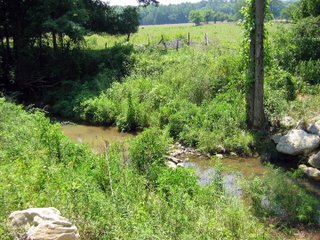Flame Chub Sweep Across Morgan And Lawrence Counties
We visited four historic flame chub sites today, two in the southwest corner of Morgan County and two in the nearby southeast corner of Lawrence County. All four sites were creeks draining north off of the Tennessee Divide, tight against the Divide which separates Tennessee River drainage fishes from the Mobile drainage species on the south side of the Divide. The low mountains in this area are known as the Little Mountains, sandstone remnants of ancient barrier islands along a shallow sea.
Our first stop, Crowdabout Creek in Morgan County, didn't yield any flame chubs. The creek is a series of pools connected by shallow riffles. We netted lots of sunfish, and some stonerollers and blackspotted topminnows. But nary a flame chub.
Our next stop was about 3 km to the northwest at a site at Dutton Creek along S. Danville Road. Dutton Creek is a tributary to Crowdabout Creek. This one looked good at first site with clear, flowing water over gravel running through cow pastures (see picture below). There was some broken beer bottle glass but we could avoid it. We found smallmouth bass, bluegills, green sunfish,stonerollers, creek chubs, black darters, blacknose dace and... one flame chub! I didn't ID the flame chub until we got home, though. The interesting thing about this site was that the TDS was way high at 213 ppm, probably from heavy cow use? At least we avoided all of the rusty barbed wire hanging off of trees along the creek.
 We moved towards our next two stops, along County Road 86 in Lawrence County to the west on the edge of the Bankhead National Forest. CR 86 turned out to be a recently well-graded and very engineered gravel road inside the Bankhead, running south into the heart of the Black Warrior Wildlife Management Area. Gillespie Creek was our first stop and it was well trampled by horses. The creek was mostly one deep pool below the road, drizzling into a longer series of stagnant, woody debris-choked pools. We pulled the seine through the first pool and found an interesting diversity of minnows: scarlet shiners, striped shiners, creek chubs and rosyside dace. Lower pools yielded only Gambusia, as far as we could work the seine. We found no flame chubs in this creek. Below is a photo of the roadside pool; notice that the plants in the foreground are silvery from a coating of gravel dust kicked up by passing vehicles.
We moved towards our next two stops, along County Road 86 in Lawrence County to the west on the edge of the Bankhead National Forest. CR 86 turned out to be a recently well-graded and very engineered gravel road inside the Bankhead, running south into the heart of the Black Warrior Wildlife Management Area. Gillespie Creek was our first stop and it was well trampled by horses. The creek was mostly one deep pool below the road, drizzling into a longer series of stagnant, woody debris-choked pools. We pulled the seine through the first pool and found an interesting diversity of minnows: scarlet shiners, striped shiners, creek chubs and rosyside dace. Lower pools yielded only Gambusia, as far as we could work the seine. We found no flame chubs in this creek. Below is a photo of the roadside pool; notice that the plants in the foreground are silvery from a coating of gravel dust kicked up by passing vehicles.
Finally, about 1.5 km further down CR 86, we came to Lee Creek, our last stop. This creek looked even sadder than Gillespie. There was evidence that road construction had strongly affected creek, from the way that culverts carried water under the road to a truly weird feature: it looked like frontloaders had driven down the creek bed about 100 meters and deposited large amounts of road gravel as enhanced banks. All this seemed to do was create a very well defined series of stagnant pools filled with woody debris. As at Gillespie, there was one pool right below the road that looked OK. Pulling the seine through it came up with a large number of rosyside dace, and nothing else.
Below is a picture of the road crossing Lee Creek. Nice road, not so nice creek. I hope my friends in the Forest Service won't be upset if I say that this road seems to have degraded the local creeks.
So now my formal count is 31 historic flame chub sites visited in north Alabama, with flame chubs found at 10 of them. We're staying at a very steady 70% range decline.


0 Comments:
Post a Comment
<< Home